weight YAMAHA YFM50S 2004 User Guide
[x] Cancel search | Manufacturer: YAMAHA, Model Year: 2004, Model line: YFM50S, Model: YAMAHA YFM50S 2004Pages: 350, PDF Size: 5.87 MB
Page 214 of 350
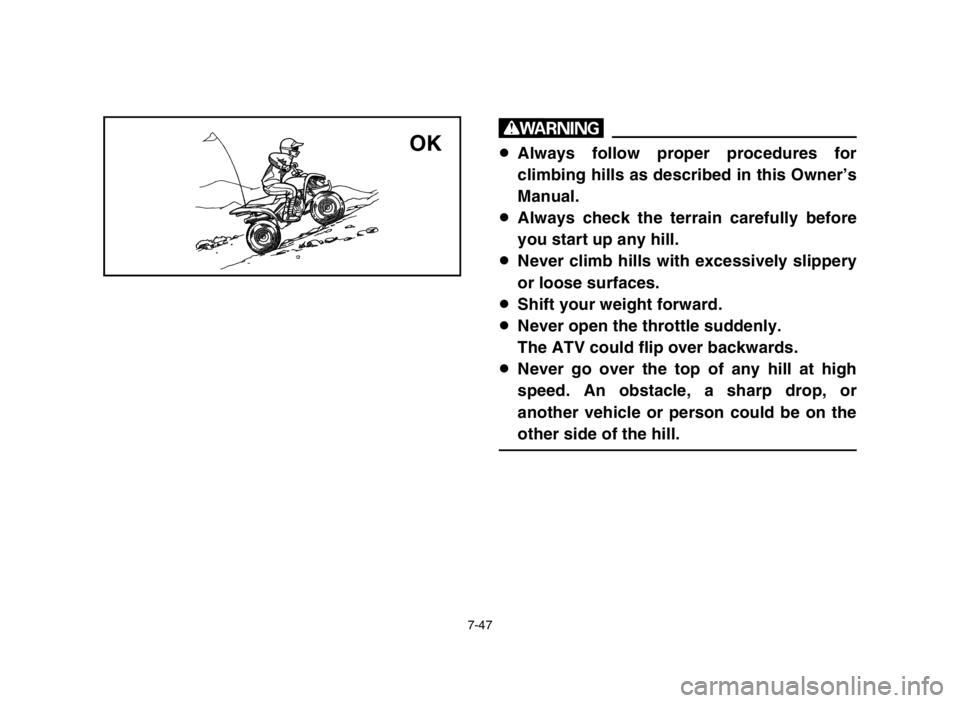
7-47
w
8Always follow proper procedures for
climbing hills as described in this Owner’s
Manual.
8Always check the terrain carefully before
you start up any hill.
8Never climb hills with excessively slippery
or loose surfaces.
8Shift your weight forward.
8Never open the throttle suddenly.
The ATV could flip over backwards.
8Never go over the top of any hill at high
speed. An obstacle, a sharp drop, or
another vehicle or person could be on the
other side of the hill.OKOK
5YF-9-60 7 4/24/03 6:35 PM Page 190
Page 216 of 350
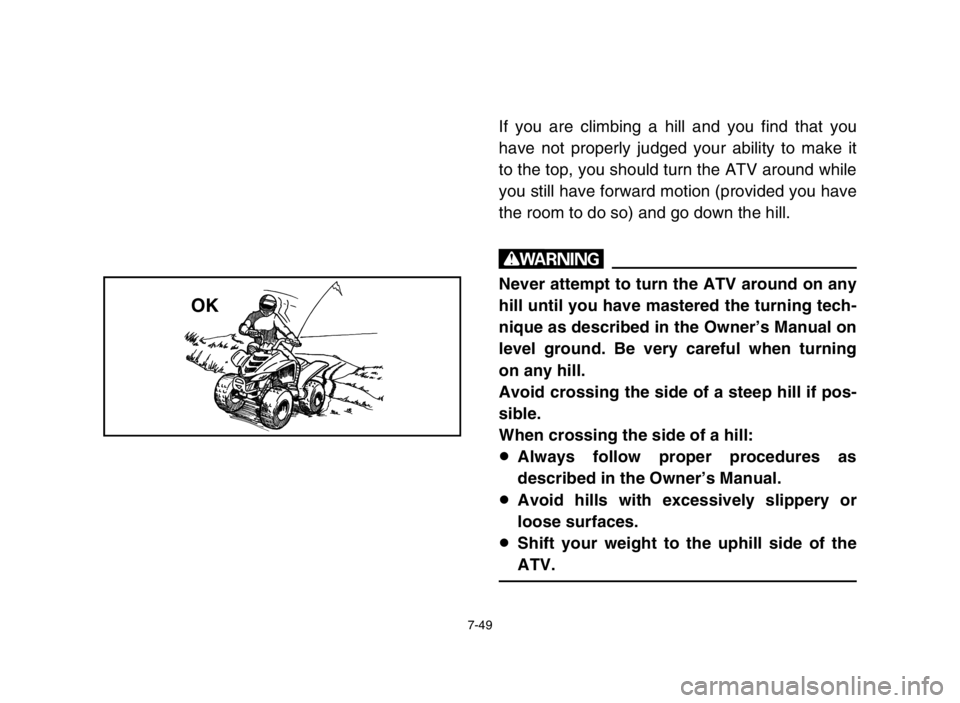
7-49
If you are climbing a hill and you find that you
have not properly judged your ability to make it
to the top, you should turn the ATV around while
you still have forward motion (provided you have
the room to do so) and go down the hill.
w
Never attempt to turn the ATV around on any
hill until you have mastered the turning tech-
nique as described in the Owner’s Manual on
level ground. Be very careful when turning
on any hill.
Avoid crossing the side of a steep hill if pos-
sible.
When crossing the side of a hill:
8Always follow proper procedures as
described in the Owner’s Manual.
8Avoid hills with excessively slippery or
loose surfaces.
8Shift your weight to the uphill side of the
ATV.
OK
5YF-9-60 7 4/24/03 6:35 PM Page 192
Page 220 of 350
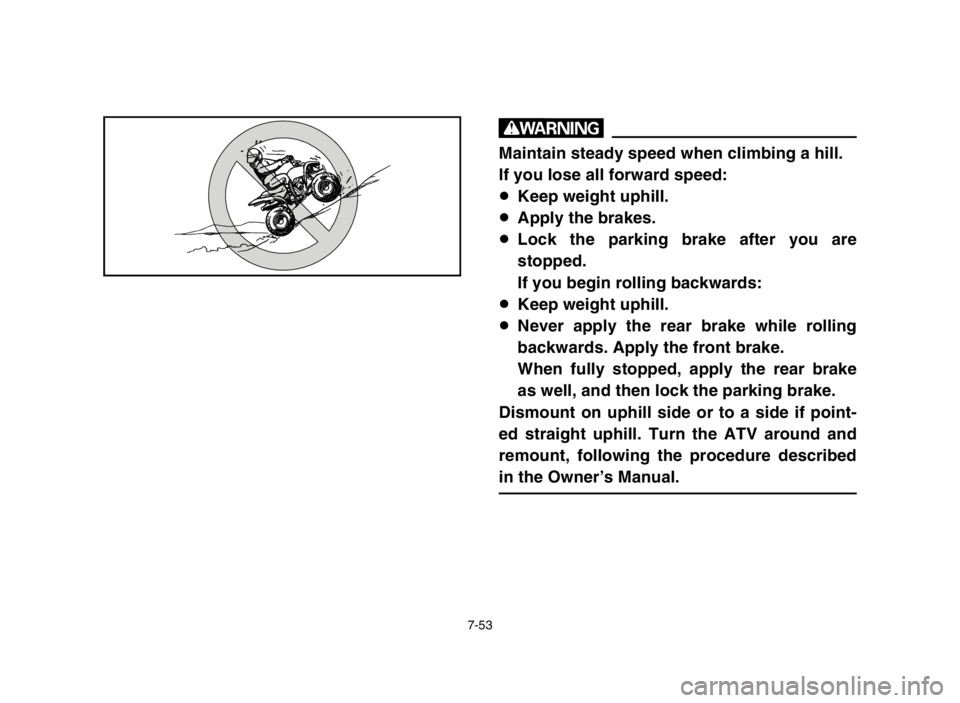
7-53
w
Maintain steady speed when climbing a hill.
If you lose all forward speed:
8Keep weight uphill.
8Apply the brakes.
8Lock the parking brake after you are
stopped.
If you begin rolling backwards:
8Keep weight uphill.
8Never apply the rear brake while rolling
backwards. Apply the front brake.
When fully stopped, apply the rear brake
as well, and then lock the parking brake.
Dismount on uphill side or to a side if point-
ed straight uphill. Turn the ATV around and
remount, following the procedure described
in the Owner’s Manual.
5YF-9-60 7 4/24/03 6:35 PM Page 196
Page 222 of 350

7-55
RIDING DOWNHILL
When riding your ATV downhill, shift your weight
as far to the rear and uphill side of the ATV as
possible. Move back on the seat and sit with
your arms straight. Allow the engine compres-
sion to do most of the braking for you. Improper
braking may cause a loss of traction.
Use caution while descending a hill with loose or
slippery surfaces. Braking ability and traction
may be adversely affected by these surfaces.
Improper braking may also cause a loss of trac-
tion.
Whenever possible, ride your ATV straight
downhill. Avoid sharp angles which could allow
the ATV to tip or roll over. Carefully choose your
path and ride no faster than you will be able to
react to obstacles which may appear.
5YF-9-60 7 4/24/03 6:35 PM Page 198
Page 224 of 350
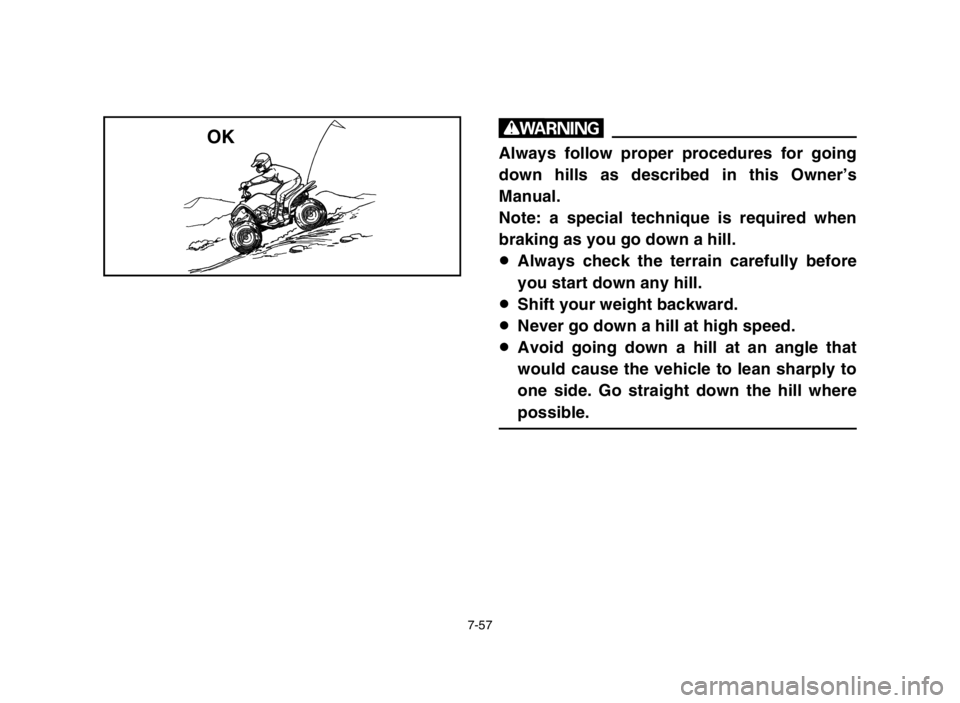
7-57
w
Always follow proper procedures for going
down hills as described in this Owner’s
Manual.
Note: a special technique is required when
braking as you go down a hill.
8Always check the terrain carefully before
you start down any hill.
8Shift your weight backward.
8Never go down a hill at high speed.
8Avoid going down a hill at an angle that
would cause the vehicle to lean sharply to
one side. Go straight down the hill where
possible.OK
5YF-9-60 7 4/24/03 6:35 PM Page 200
Page 226 of 350

7-59
CROSSING A SLOPE
Traversing a sloping surface on your ATV
requires you to properly position your weight to
maintain proper balance. Be sure that you have
learned the basic riding skills on flat ground
before attempting to cross a sloping surface.
Avoid slopes with slippery surfaces or rough ter-
rain that may upset your balance.
As you travel across a slope, lean your body in
the uphill direction. It may be necessary to cor-
rect the steering when riding on loose surfaces
by pointing the front wheels slightly uphill. When
riding on slopes be sure not to make sharp turns
either up or down hill.
5YF-9-60 7 4/24/03 6:35 PM Page 202
Page 228 of 350
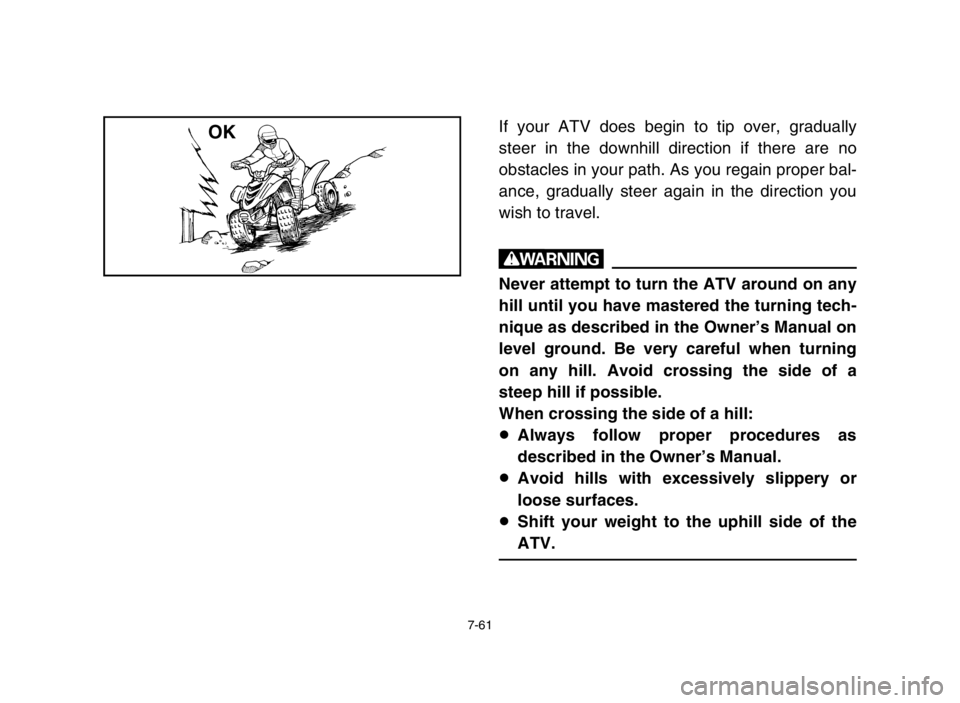
7-61
If your ATV does begin to tip over, gradually
steer in the downhill direction if there are no
obstacles in your path. As you regain proper bal-
ance, gradually steer again in the direction you
wish to travel.
w
Never attempt to turn the ATV around on any
hill until you have mastered the turning tech-
nique as described in the Owner’s Manual on
level ground. Be very careful when turning
on any hill. Avoid crossing the side of a
steep hill if possible.
When crossing the side of a hill:
8Always follow proper procedures as
described in the Owner’s Manual.
8Avoid hills with excessively slippery or
loose surfaces.
8Shift your weight to the uphill side of the
ATV.
OK
5YF-9-60 7 4/24/03 6:35 PM Page 204
Page 236 of 350
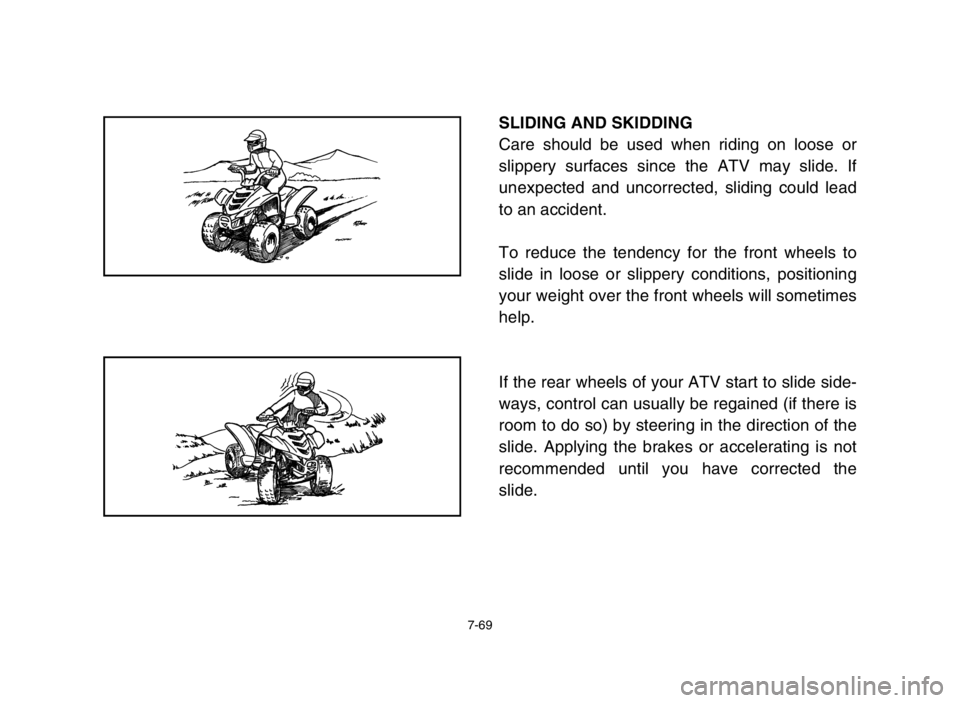
7-69
SLIDING AND SKIDDING
Care should be used when riding on loose or
slippery surfaces since the ATV may slide. If
unexpected and uncorrected, sliding could lead
to an accident.
To reduce the tendency for the front wheels to
slide in loose or slippery conditions, positioning
your weight over the front wheels will sometimes
help.
If the rear wheels of your ATV start to slide side-
ways, control can usually be regained (if there is
room to do so) by steering in the direction of the
slide. Applying the brakes or accelerating is not
recommended until you have corrected the
slide.
5YF-9-60 7 4/24/03 6:35 PM Page 212
Page 240 of 350

7-73
WHAT TO DO IF ...
This section is designed to be a reference guide
only. Be sure to read each section on riding
techniques completely.
WHAT TO DO ...
8If your ATV doesn’t turn when you want it to:
Bring the ATV to a stop and practice the turn-
ing maneuvers again. Be sure you are putting
your weight on the footboard to the outside of
the turn. Position your weight over the front
wheels for better control. (See pages 7-39–
7-43.)
8If your ATV begins to tip while turning:
Lean more into the turn to regain balance. If
necessary, gradually let off the throttle and/or
steer to the outside of the turn. (See pages
7-39–7-43.)
5YF-9-60 7 4/24/03 6:35 PM Page 216
Page 244 of 350

7-77
8If your ATV is traversing a sloping surface:
Be sure to ride with your weight positioned
towards the uphill side of the ATV to maintain
proper balance. If the ATV starts to tip, steer
down the hill (if there are no obstacles in your
way) to regain balance. If you discover that
the ATV is going to tip over, dismount on the
uphill side. (See pages
7-59–7-61.)
8If your ATV encounters shallow water:
Ride slowly and carefully through slow mov-
ing water, watching for obstacles. Be sure to
let water drain from the ATV and CHECK
YOUR BRAKES FOR PROPER OPERATION
when you come out of the water. Do not con-
tinue to ride your ATV until you have regained
adequate braking ability. (See pages 7-63–
7-65.)
5YF-9-60 7 4/24/03 6:35 PM Page 220